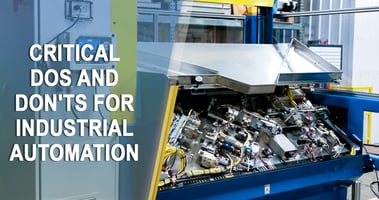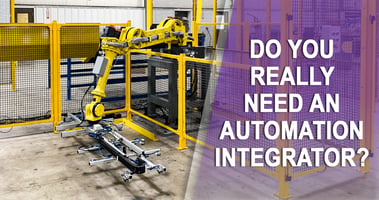As consumers evolve, so do their expectations for manufactured goods. This evolution—among other...
5 Advantages of Machine Tending Automation

Machine tending is often considered a highly complex process within manufacturing facilities. Because of this perceived complexity—and the obvious concern over bottom-line impacts—some companies have been slow to adopt automation for machine tending functions. Overlooking the distinct benefits of machine tending automation, however, can be a major disadvantage in terms of competitiveness and overall profitability.
Just about any organization that relies on machine tending, from global businesses to local shops, can benefit from automating this aspect of their operation. If you’re loading and unloading machinery using manual processes that are not adding value to the line, there's a significant opportunity to reduce operational costs and boost profitability. Here are five of the most notable ways machine tending automation can positively affect your business.
1. Increased Throughput
When humans perform machine tending functions, there's the inevitability of productivity inhibitors like shift changes, breaks, sick days, and so on. These are simply routine needs and realities surrounding workers. Every facility managing people on their lines understands these factors, though some may mistakenly consider them unavoidable.
Machines, on the other hand, are not prone to fatigue, sickness, loss of focus or any of the other human limitations that can impede uptime. This means that when you leverage automation for machine tending functions, you access immense throughput gains. Your lines become faster, smoother and unhampered by the bottlenecks and other lags that occur as a result of manual labor.
Automation has the distinct ability to run through breaks and offset the need for shift changes. In essence, it can be programmed to function unmanned and without the need for cumulative downtime determinants. Automated machine tending solutions can even enable businesses to meet greater throughput demands without accruing the cost of additional manpower. At a head, automating your processes will utilize your equipment more efficiently, leading to greater throughput and an increase in your overall manufacturing capacity.
2. Greater Consistency
Another major difference between humans and automation is that humans are both fallible and limited in energy, concentration and invariability. No matter how dedicated a worker is to his or her job, there’s simply no matching the consistency and reliability of a machine.
Machines are specifically programmed to perform the same function in an identical way each and every time, all with an unrivaled level of precision and repeatability. For machine tending purposes, this equates to parts loading and unloading tasks that unfold without interruption, hesitation, deviation or irregularity.
That’s a major advantage in terms of ensuring product and process consistency. From applications like grinding, milling, welding and operating injection or compression molds to stamping, punching, trimming and forging, there’s immense value in a machine’s capacity to perform machine tending functions consistently and efficiently.
3. Reduced Labor Costs
Machine shops are no strangers to the challenges and expense of sourcing, managing, compensating and retaining workers, particularly for jobs that can be repetitive, physically demanding, dangerous or unpleasant. The employee requirements related specifically to machine tending applications can even pose risks like injury-caused downtime and liability for the business—none of which are considered minor costs for a production operation.
Automation is fundamental to minimizing these types of labor costs. By integrating automated machine tending solutions, you greatly reduce the need to source workers for associated tasks. In addition to deflating ongoing labor costs, the use of machine tending automation frees up your current workforce for jobs within your operation that do require valuable human intelligence and flexibility
4. Better Quality & Reliability
Let’s not forget about the importance of product quality or the critical impacts of damage and waste. When it comes to machine tending functions, human operators are at risk of dropping or mishandling parts as well as improperly loading and unloading machines. It all goes back to the limitations of humans versus the reliability of automated solutions.
Here again, automation has the upper hand. It can deliver a level of precision and accuracy that minimizes the need for stoppages and waste. The cost of product damage can be formidable in a manufacturing setting, as can the expense of operator error that slows a production line.
5. Aggregate Value-Adds
Perhaps one of the least obvious but no less valuable benefits of leveraging machine tending automation is the capacity for machines to run multiple functions at once, thereby maximizing productivity, increasing efficiency and creating significant profitability gains.
To get a better understanding of this concept, think about what your workers can realistically accomplish on the line in terms of machine tending tasks. When loading and unloading parts, other cell-related tasks must be handled by additional workers or on a slower timeline.
With machine tending automation solutions, however, you have the ability to perform more than one function simultaneously. For example, an automated solution or robotic system could hypothetically carry out quality control tasks, palletizing functions, packaging requirements or efforts like material removal, deburring and assembly—all right in front of a CNC machine. This means accomplishing more, faster, and with less need for costly manpower.
Answering the Big Question
Considering the benefits to be gained by leveraging automated solutions for machine tending needs, there’s been increasing buzz about this option across a wide array of manufacturing industries. As organizations focus on important outcomes like profitability and growth, many find themselves asking the same question: Is machine tending automation right for our business?
But, to be honest, there’s a much more essential and illuminating question to be asking, and it’s this: Why AREN’T you taking advantage of machine tending automation already?
Whatever inquiries you have about adopting automation solutions, or concerns you’re weighing regarding ROI, the best way to make a smart decision is to talk to an integration specialist with in-depth knowledge and experience in designing and building automated systems suited perfectly for unique manufacturing requirements. A dedicated integration specialist who’s worked with all types of systems at an array of different facilities can give you the insight you need to stop wasting resources and start boosting profitability with valuable machine tending automation.


.jpg?height=200&name=Blog%20Post%2015%20-%20Banner%20Photo%20-%20FINAL%20(1).jpg)
